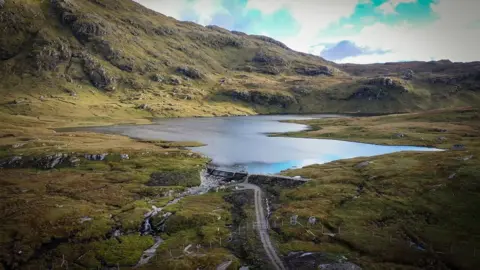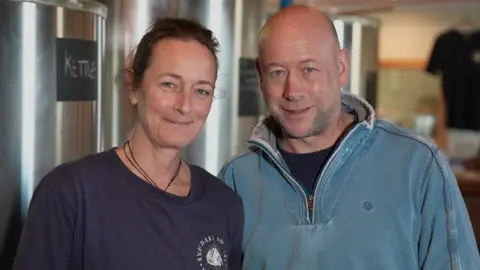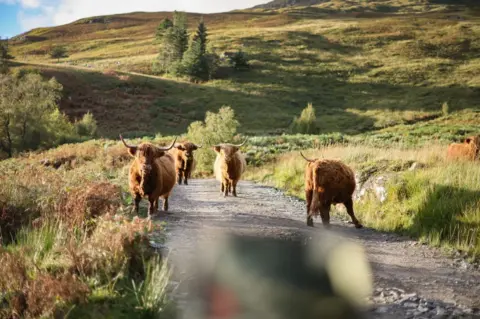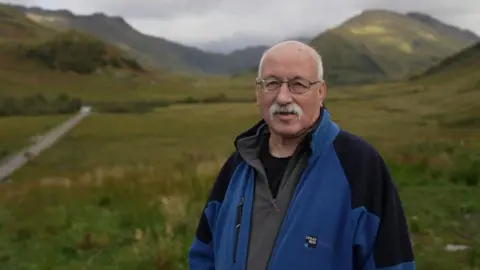The Highland haven insulated from rising energy prices
Scotland's last great wilderness seems an unlikely haven from the energy crisis gripping the nation.
Knoydart is one of the most rugged and remote parts of the British Isles, accessible only by boat or via a two-day hike through glacier-sculpted glens and mountains.
Life on this stunning slice of land between Loch Nevis and Loch Hourn in the west highlands can be tough, especially with winter approaching.
But the 120 inhabitants of Knoydart have one huge advantage over the rest of the country - a body of water nestled out of sight high above the village of Inverie.
It is called Loch Bhraomisaig and from here water gushes at 129 litres per second down a big pipe to a turbine which powers a post office, primary school, private homes and more.
 BBC
BBCHydroelectric schemes are not unusual in Scotland, where lochs and reservoirs currently provide enough water to power around half the nation's homes, according to the Scottish Environment Protection Agency.
Knoydart, though, is different - so remote that it is not connected to the National Grid, meaning prices here are not dictated by the wholesale cost of more expensive forms of energy such as gas.
The 280kW hydroelectric scheme is run by a community trust called Knoydart Renewables.
It is a "loch to kettle system," declares the chair, Frank Atherley, after proudly showing us where the racing water is turned into electricity in a smallish hut - which I describe, to his great amusement, as the turbine hall.
Mr Atherley says that if it wasn't for Knoydart Renewables, there would probably be just "20 or 30 people living here with tumbleweed blowing down the streets".
Plus it's greener than the alternative - burning diesel to make electricity.
 BBC
BBCAmong those grateful for the plentiful supply of renewable power is Knoydart's forester Grant Holroyd. He says recent upgrades to the hydro's capacity have enabled the community to invest in an electric sawmill, an electric timber-drying kiln and an electric planer.
"We've just got the tractor to decarbonise now," he says with a smile.
Mr Holroyd is also chair of the Knoydart Foundation, which in 1999 staged a community buyout of the 17,000-acre Knoydart estate.
"We have won the first stage of the fight, but we must continue our struggle to establish Knoydart as a thriving community," foundation director Bernard Evemy said at the time.
Today the foundation says the community is indeed thriving, proclaiming on its website that "from tourism and hospitality to construction, forestry and farming, there is a lot going on."
 BBC
BBCSam and Matt Humphrey are very much part of that activity.
They run Knoydart Brewery, producing a range of beer in bottles and casks in an old Roman Catholic chapel. For them the hydro has been a Godsend.
"I think if we transplanted this brewery onto the mainland, I would be having sleepless nights about the price of electricity," says Matt.
Sam says the hydro scheme is "critical" because "we know we'll be able to keep the lights on and keep the beer coming".
In contrast, she says, a lot of small breweries on the mainland are shutting down because they can't afford to keep running.
 BBC
BBC BBC
BBCThe scheme is an example of how the community has pulled together, she says.
"I think it gives people an idea of what can be achieved if everybody works as a team and gets behind something.
"It's not a small feat to set up and run a hydroelectric company. I mean it's a big, big project."
But now more than ever that effort is worth it, insists Mr Atherley.
"The energy emergency has no effect on us in terms of our electricity production," he adds.
 BBC
BBCThat stability has helped to build a sense of confidence in the future of Knoydart says Steph Harris, who sells the Humphreys' beer in the Old Forge pub in Inverie, another community enterprise, which is officially Great Britain's most remote pub.
Costs in general are high on the peninsula because of its remoteness, says Ms Harris, "so having affordable electricity, particularly for businesses, is really important.
"It's one less thing that we have to worry about," she says.
The scheme does not currently cover every home in Knoydart. Some of the more remote properties generate their own power either with diesel generators or by using water from burns.
Or, as Mr Atherley puts it "they have to knit their own electricity out of seaweed".
 BBC
BBC"That too may change. Knoydart Renewables plans to extend its network after having completed a £2.7m upgrade, part funded by a £2.4m Scottish government grant along with financial assistance from the Knoydart Foundation and Perth-based energy giant, SSE.
Bills may eventually rise a little to maintain the infrastructure admits Mr Atherley but he insists the increases will be nothing like those the rest of the country is enduring."
Of course not every community has the resources to set up its own hydroelectric scheme but Mr Atherley argues that the community trust model could be replicated in some other parts of the country.
Steph Harris says it's one reason why Knoydart is thriving.
"I'm building a house right now and [the hydro scheme] means that I know that I will be able to have power, which is obviously very important," she points out.
"There's more people here, there's more new businesses, there's triple the amount of kids in the school than there was when I was there," adds Ms Harris.
This is the sound of optimism in a rare corner of the country without an energy emergency.

 BBC
BBC BBC
BBCAdditional images by Kris Miller
